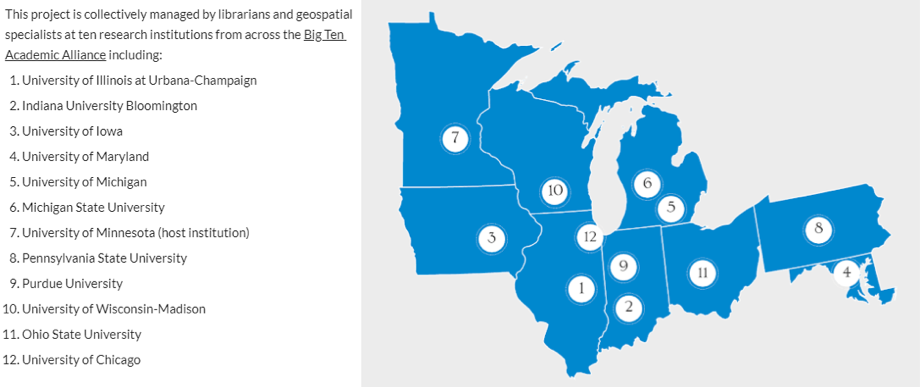This post was authored by Jordan Blekking, a Scholarly Communication graduate student and PhD student in the Department of Geography.
For those searching for open source spatial data, the Government Information, Maps, and Microform Services (GIMMS) at the Herman B Wells Library can help. GIMMS provides access to a wide range of spatial datasets that provide an array of data from around the world. In particular, GIMMS provides access to two exceptional databases to meet your data needs: IndianaMap and the Big Ten Geoportal.
IndianaMap is the largest publicly available collection of spatial data for the state of Indiana. The data is made available through a collaboration between multiple federal, state, and local governments, organizations, and universities. The Indiana Geological Survey developed and maintains the data collection. Data from all 92 Indiana counties is available on IndianaMap.

Data layers are organized around eight general themes: Demographics, Environment, Geology, Government, Hydrology, Imagery, Infrastructure, and Reference. Examples of data are Census data cleaned and clipped to the state of Indiana, Wind Power Speed and Density, School districts, Elevation data, Political Boundaries, and much more. Data is available for download, as a Web Map Service (WMS), or viewable on the IndianaMap Map Viewer.
The Big Ten Geoportal provides access to geospatial data and resources selected and curated by librarians and geospatial specialists at twelve research institutions in the Big Ten Academic Alliance, including Indiana University Bloomington. The geoportal provides access to web services, digitized historical maps, and geospatial resources, including GIS datasets. Data available through the Big Ten Geoportal is wide ranging in its subject matter, as well as its geographic extent. The site contains an extensive collection of digitized maps, which would be especially helpful for historians or those with research interests related to history.

Each of these unique data sources allow users the opportunity to spatially integrate data in order to answer questions like: “What types of demographic changes have happened in Indianapolis over the last twenty years?” and “Where should a new grocery store be established?”
Find more open spatial data on our library guide: guides.libraries.indiana.edu/GIS
Leave a Reply